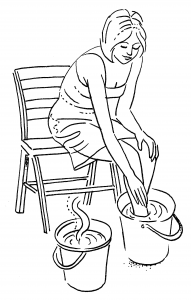Alternate hot and cold Foot Baths:
These are excellent water therapies for complaints such as swollen ankles, foot infections, chilblains, neuralgia, headache, catarrh, colds, cold feet, congestion of abdomen, poor circulation, burning sensation in the feet and more.
Use two containers large enough to cover both feet to the ankles. Fill one with hot water as hot as you can tolerate (approximately 41ºC – 42ºC) and one with cold water.
Put your feet into the hot water for three minutes, then place them immediately into the cold water for 10-15 seconds. Repeat this sequence for about 20 minutes.
By alternating, this will produce a powerful reaction.
Make sure the temperature of the water remains constant by adding fresh hot water whenever necessary. End the foot baths with cold water.
Hot Foot Bath:
Hot foot baths are excellent water therapy for the relief of cramps in feet and legs, and can be used to overcome insomnia, to relieve pain associated with neuralgia, gout and menstrual cramps.
Use a bath tub or other large container such as a large bucket. Start with warm water and increase the temperature of the water until it is as hot as you can tolerate – (approximately 41ºC – 42ºC).
Soak feet for 20 minutes.
When the water cools down, add some more boiling water to maintain the temperature.
Dry the feet with a towel and keep them wrapped for about 15 minutes.
Alternate hot and cold Hand Bath:
As there are many reflex points in the hands, hand baths can affect other parts of the body and are recommended to restore healthy circulation in the wrists and hands. It can be used in most injury rehabilitation of this area. Hand baths help control mild haemorrhages in other parts of the body, relieve frostbite and are an excellent treatment for cold hands.
The principles are the same as for hot and cold foot baths. Have two containers. Put hands in hot water (approximately 41ºC – 42ºC) for three minutes and then place them immediately into the cold water for 10-15 seconds.
Repeat this sequence for about 20 minutes.
Herb Baths:
These are a wonderful way to relax at the end of a long day.
By using specific medicinal herbs, you can make your bath therapeutic as well as relaxing—you can breathe in the vapours of the herbs, and the active ingredients in the herbs are also absorbed through your skin. Herbal baths can be especially helpful for relieving the symptoms of arthritis, rheumatism, cramps and skin conditions.
To prepare a herb bath, steep approximately 200 g of dried herbs in 2–3 litres of cold water for 12 hours. Gently heat the infusion and strain into warm bath water.*
*Alternatively, you can simply fill a piece of clean pantyhose or sock with the recommended amount of herbs. Tie with a knot to secure and place it in a large bowl or bucket. Pour boiling water over the herb sachet and leave to infuse for 10–15 minutes. Add the infused liquid and the herbal sachet to warm bath water. Relax in your herb bath for 10–15 minutes.
At ASOHM we ensure that our students understand the various concepts of health and disease, along with different approaches to the treatment of human disorders. Enrol in our Health and Disease Lesson 2 today!

